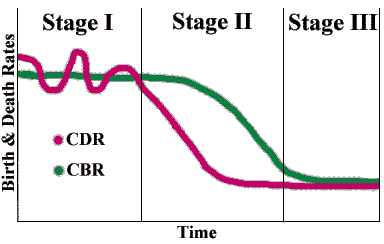

The Demographic TransitionCBR & CDRThe model is based on the change in crude birth rate (CBR) and crude death rate (CDR) over time. Each is expressed per thousand population.
 Stage IPrior to the Industrial Revolution, most countries had high CBRs and CDRs. Births were high because more children meant more workers on the farm and with the high death rate, families needed more children to ensure survival of the family. Death rates were high due to disease and a lack of hygiene. The high CBR and CDR were somewhat stable and meant slow growth of a population. Occasional epidemics would dramatically increase the CDR for a few years (represented by the "waves" in Stage I of the model).Stage IIIn the mid-18th century, the death rate in Western European countries dropped due to improvement in sanitation and medicine. Out of tradition and practice, the birth rate remained high. This dropping death rate but stable birth rate in the beginning of Stage II contributed to skyrocketing population growth rates. Over time, children became an added expense and were less able to contribute to the wealth of a family. For this reason, along with advances in birth control, the CBR was reduced through the 20th century in developed countries. Populations still grew rapidly but this growth began to slow down.Many less developed countries are currently
in Stage II of the model. For example, Kenya's high CBR of 32 per 1000
but low CDR of 14 per 1000 contribute to a high rate of growth (as in mid-Stage
II).
Stage IIIIn the late 20th century, the CBR and CDR in developed countries both leveled off at a low rate. In some cases the CBR is slightly higher than the CDR (as in the U.S. 14 versus 9) while in other countries the CBR is less than the CDR (as in Germany, 9 versus 11). (You can obtain current CBR and CDR data for all countries through the Census Bureau's International Data Base). Becuase of low CBRs and CDRs, immigration from less developed countries now accounts for much of the population growth in developed countries that are in Stage III of the transition. Countries like China, South Korea, Singapore, and Cuba are rapidly approaching Stage III.The ModelAs with all models, the demographic transition model has its problems:
An understanding of this model, in any of its forms, will help you to better understand population policies and changes in developed and less developed countries around the world.
For More InformationLearn more in the World Population category of Net Links. This info was originally posted here. |